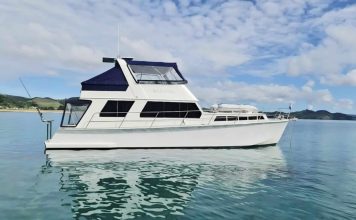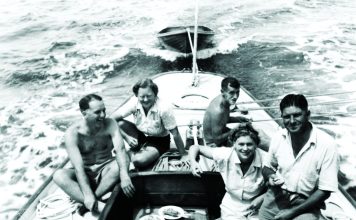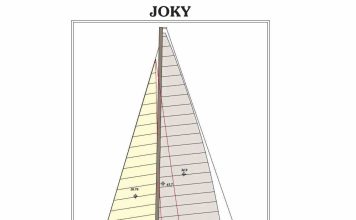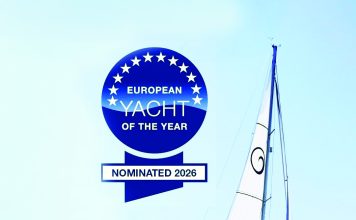We’ve all been there: waiting on the boat ramp for the guy who’s parked his trailer half a kilometre away. The queue to retrieve is backing up as Mum stands up to her thighs in the water, hanging out the boat, while the kids wriggle and whine and want to get out NOW!
Surely there’s a better way? What if the trailer was actually part of the boat? It might sound like a simple idea, but it’s taken thousands of hours of design work and years of development to get the first Penguin amphibious inflatable on the road – and on the water.
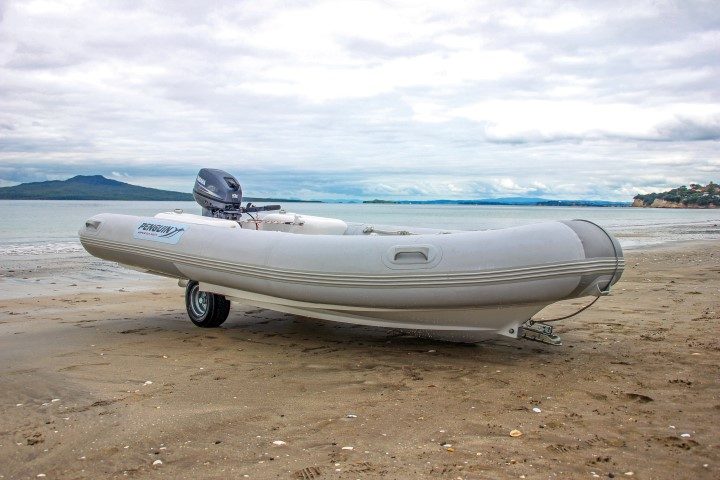
Former investment banker David Gibson has turned what has been a long-term interest in amphibious craft into a reality, working with Craig Loomes and Andre Moltschaniwskyj at LOMOcean Design to produce the first production boat, launched in May. Loomes and Moltschaniwskyj are also shareholders in the Penguin venture. The first batch of 15 boats for sale are currently under construction in Indonesia, and will be ready for new owners in August.
Gibson is a lifelong boatie, having owned a range of vessels, including a 7m Sealegs which he kept at his bach at Onetangi, on Waiheke Island. “It’s the capital of amphibious craft – there are 25 or 30 Sealegs at Onetangi. At every barbecue all the boys stand in one corner and talk about their Sealegs and amphibious vehicles. There’s something about the transformation from land to water that makes everyone go ‘wow, that’s cool’. I love the Sealegs and it’s a great product, but lots of people can’t afford $200,000.”
So Gibson became interested in the idea of producing an “affordable amphibian” – a family-sized inflatable which would transition easily from road to water.
“In some ways it goes back to the idea of a Parker Craft in the ’70s: lightweight, with a 15hp on the back – the classic Kiwi piece of kit. It’s trying to reinvent that for 2017, using a ‘better by design’ philosophy, and using technology that wasn’t around at that time either.”
The Penguin has a conventional fibreglass hull, but is beamier than a similarly-sized inflatable. It also has a ‘chassis’ component to provide structural strength and make it towable on the road. The topside portion of this chassis creates a handy fibreglass seat for the skipper.
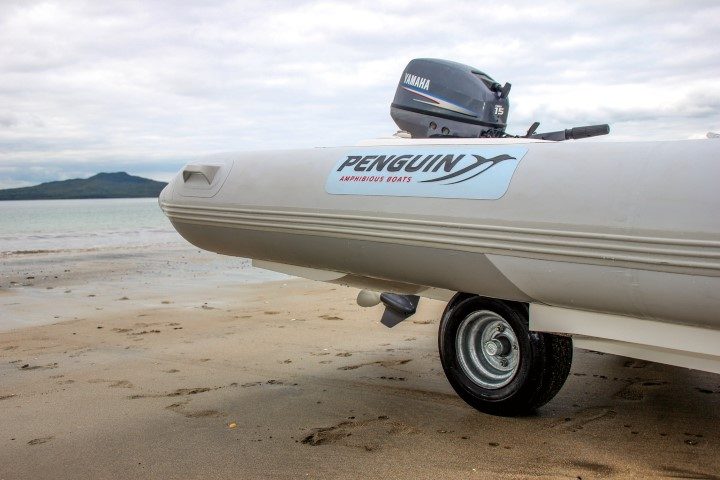
Under the water, much thought and testing has gone into creating a hull shape which will encourage the water flow to ‘jump’ the gaps where the wheels are recessed into the hull. “From a design point of view, when you put two holes in the boat for the wheels, you get horrible hull performance. It sits on its arse and doesn’t plane,” Gibson says. “So we had to think about the ways we could fix that.”
The hull design therefore has additional buoyancy aft, to make the stern sit higher in the water. Large amounts of research went into the hydrodynamics of the hull shape, to maintain the surface tension of the water rushing past the gap.
“It took three years to get that right, and was the biggest challenge in getting the boat to perform,” Gibson says. “But now, when we put a camera in there and film the surface of the water underneath the holes, it’s like a sheet of glass.”
The arrangement for raising and lowering the wheels is so simple it almost seems agricultural: until you consider how much thought has gone into it. Above the axle, a laminated lever arm (called the WAL – wheel activation lever) is attached to a carbon tube from Kilwell.
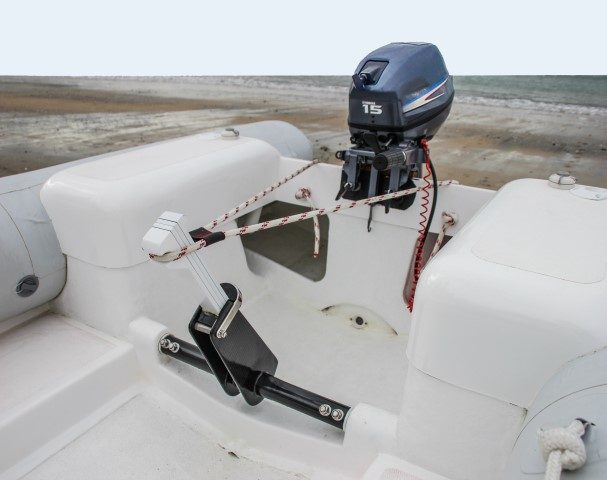
All the user does is remove the loop of Dyneema polyethylene rope securing it upright (attached to the transom with a couple of sturdy knots) and push it down once the boat is afloat. To redeploy the wheels, you just lift it up and secure it with the rope loop, which can double as a towing harness while you’re on the water. Simple? Genius.
“We had to design the trailor suspension differently, as traditional suspension has springs or levers made of steel, which rust or add complexity,” says Gibson. “One of our innovations was to put the spring in the lever arm, which provides suspension for both wheels, and you can do it with composites. It’s a classic New Zealand innovation thing, around finding a solution, something which has never been done before.”
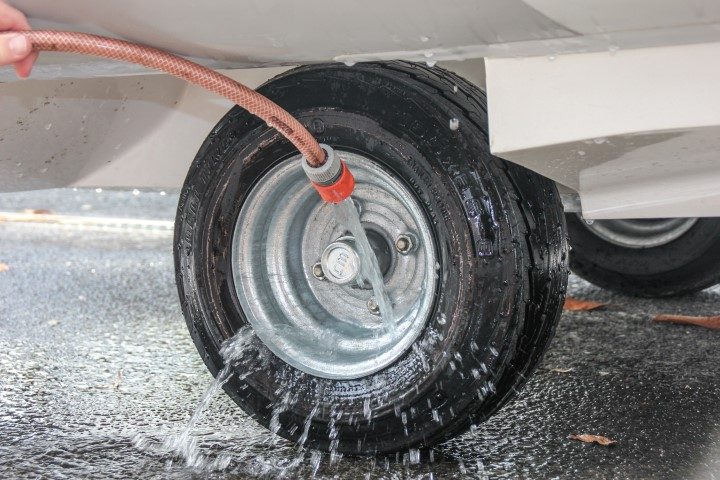
A simple pin and split pin hold the drawbar in position, and another piece of smart thinking came when the team discovered there is no road-legal requirement that a trailer safety strop has to be made of steel. “So we made a high-strength Dyneema strop that cost five dollars, and used yachting knots to secure it. So now the strop can stay with the boat, and you can use it as a tender rope.” Penguin has a patent application pending for all these design innovations.
The design team worked with mechanical design engineers TSV to certify that the trailer design is legally compliant, safe and roadworthy. When boats are delivered to new owners they are road-registered as trailers and have a WOF.
As well as simplicity, weight saving was another design driver: all up, the hull, hard-wearing Hypalon synthetic rubber tubes and the integrated tractor drawbar and wheels weigh just 151kg — “and a lot of thinking has gone into every one of those kilos,” says Gibson.
A 15–25hp engine adds another 38–48kg, keeping the whole package less than 200kg and easily manoeuvrable by one or two people – easy to pull up the beach or boat-ramp on its fat, jetski trailer-style tyres.
And of course the price. The base package is $10,000 plus GST, so depending on which outboard you select, the whole thing comes in around $15,000 plus GST — boat and integrated trailer.
“To achieve that price point we’ve had to use an overseas manufacturer — we did try to do it locally but we just couldn’t get a price point that makes it worthwhile,” Gibson says.
Consequently, the boats are built at North Sea Boats in Indonesia, which specialises in military, SAR and law enforcement craft. It has plenty of experience in both composites and inflatable boats. The aim is to build 15 boats in each production run, which can be shipped to New Zealand in a single 40-foot container.
Gibson has worked with several local agents to develop a selection of outboard packages. “You decide what you want, we put it together and deliver it to you with the outboard, registered and warranted,” Gibson says. The ‘road kit’ includes the trailer drawbar and a light board, or for tender use you can buy the basic boat with wheels but without trailer capability.
OFF THE RAMP
So, enough standing around looking at it – how does it work in practice?
We take the boat out for a spin off the Takapuna boat ramp, on Auckland’s North Shore – a typically steep, sometimes slippery and often congested ramp, which is mercifully free of other traffic on a sunny Wednesday morning. We sleeve the drawbar by the car then easily pull the boat across to the ramp.
“I’ve got two girls and a wife who are not much help around the boat ramp, and I can do it myself,” Gibson says, then demonstrates this. I’m no Valerie Adams and he’s got a broken arm, yet we have absolutely no trouble launching and retrieving.
Hopping aboard, lifting up the wheels is incredibly simple using the WAL then we are off in ‘boat mode’, without anyone having to run and stash the trailer. The ride is smooth and dry and feels no different to a conventional inflatable, with a nicely elevated and comfortable helm position provided by the fibreglass chassis construction.
Now for the reverse process. As we approach the beach, it’s a simple matter of putting the wheel down by lifting and securing the WAL, tilting the outboard to shallow mode – no need to tip it right up – and literally ‘hitting the beach’.
The key is to keep the boat moving, jumping out as soon as grounding occurs and guiding the boat up the beach out of the soft, wet sand at the water’s edge as quickly as possible. It’s very easily pulled up by Dave and I; one full-strength person could do it easily. And suddenly we have a boat on wheels again – without anyone having to go and get the trailer.
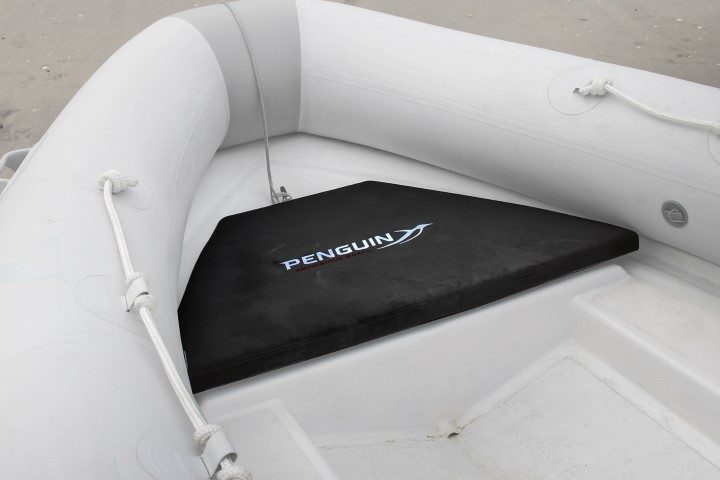
There’s no doubt that the Penguin could be a game-changer in the small-boat market, here and overseas, both as a trailerable craft and tender. Interest has already been high even though the brand’s online presence went live only in May; the Facebook page received 30,000 visits in its first few weeks.
“It definitely fires people’s imaginations, especially the affordability of it,” says Gibson.
Like all of the best ideas, this one is simple: producing a family-size, easy-to-use amphibious inflatable boat at an affordable price point. But as jazz great Charlie Mingus once said, “Making the simple complicated is commonplace; making the complicated simple, awesomely simple, that’s creativity.” With the Penguin 4m amphibious inflatable, Gibson and the LOMOcean Design team have hit that nail right on the head.
Penguin 4m
DESIGNER:
LomOcean Design
Words by John Eichelsheim, Photos by Will Calver
Written
Bookmark post
Bookmarked
Bookmark post
Bookmarked

OVERALL RATING
We gave the
an OVERALL RATING of
4
out of 5 stars
PERFORMANCE
75
%
HANDLING
75
%
ECONOMY
80
%
SPECIFICATION
80
%
BUILD QUALITY
90
%
VALUE
80
%
MODEL DETAILS
DESIGNER
LomOcean Design
SPECS
LENGTH OVER ALL (M)
4.0
BEAM (M)
1.96
DRAFT (M)
0.3
DISPLACEMENT (KG)
151
DETAILS
ENGINE
15-25hp
CONSTRUCTION
Inflatable
CONSTRUCTION DETAILS
Fibreglass hull, Hypalon tubes
Related Articles
Comments
This conversation is moderated by Boating New Zealand. Subscribe to view comments and join the conversation. Choose your plan →
This conversation is moderated by Boating New Zealand.









